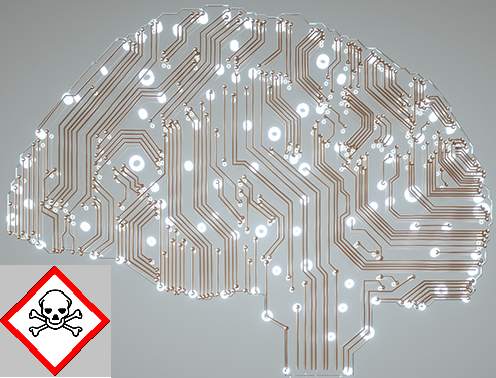Dual-use research of concern (DURC) refers to beneficial research that can easily be diverted to cause harm to public health and safety.
AI, ML and 3D printing technologies can discover and predict suitability of a chemical for use as a weapon, produce it on a relevant scale, optimally weaponize it and safely stockpile it. Pharmaceutical aerosol technologies with agriculture spraying drones for delivery of airborne chemical and biological warfare agents will have devastating results.
An article titled “Dual use of artificial-intelligence-powered drug discovery” in Nature Machine Intelligence on 7 March 2022 by Fabio Urbina and team from Collaborations Pharmaceuticals, Inc., Raleigh, NC, US, has drawn attention to existing fears that drug discovery software with artificial intelligence and machine learning can be misused for discovering novel deadly biochemical weapons, difficult to detect or trace, and with no known antidotes. In this study they used their commercial de novo molecule generator, “MegaSyn”, with an altered approach to select rather than discard toxic molecules, especially those like nerve agent VX and Novichok. In less than 6 hours it generated 40,000 known and unknown nerve agent molecules like VX that met the desired threshold of nerve toxicity. It is easier to discover highly toxic chemicals than to find an effective and safe therapeutic drug and then optimize its production and delivery.
Artificial intelligence (AI) is the simulation of human intelligence with electronic neural-like networks on a powerful computer. Such AI ability to learn and solve problems is used for natural language processing, speech recognition, face recognition like machine vision and expert systems like IBM Watson, in addition to simplifying and hastening drug discovery. IBM Watson has been used to provide personalized recommendations to cancer patients. AI is very useful in analysing big data as in commerce: optimising products, inventory, logistics etc.
Machine learning (ML) simulates a human gaining experience by performing repetitive tasks to improve performance and enhance results. A drug discovery platform uses AI with ML to study the mode of action of known drug molecules and their active parts, to discover more effective drug molecules with desirable actions, and without undesirable reactions.
Dual-use research of concern (DURC) refers to beneficial research that can easily be diverted to cause harm to public health and safety, plants and agricultural crops, commercial and other animals, the environment or national security. It usually refers to life sciences research like Gain of Function research that can be used to create viruses like Covid-19, but also includes other fields such as discovering highly toxic chemicals, engineering lethal autonomous weapons and robots, and using information technologies such as deep-fakes for misinformation and warfare. Nuclear technology was weaponised during World War II and space technology is being weaponised now.
Weaponised AI, ML and 3D printing enable rogue state and non-state entities like terrorists and criminals to design tens of thousands of toxic molecules in a matter of hours as reported by Fabio Urbina and team in the article mentioned above. Though a number of chemical warfare agents exist, and their development, stockpiling, transfer and use have been banned since World War 1, with enhanced restrictions since in 1993, covert research and development continues. AI, ML with drugs and chemicals discovery software can simplify and quicken discovery of highly toxic and hard to trace chemicals with no known antidote or treatment. 3D printing technology can make it easy to synthesise and manufacture the chemical clandestinely. These technologies can discover and predict suitability of a chemical for use as a weapon, produce it on a relevant scale, optimally weaponize it and safely stockpile it. These chemical agents can be delivered orally, usually in water or liquids, through skin or inhaled as gas or aerosol. Pharmaceutical aerosol research has helped deliver drugs deep into the lungs for asthmatic patients. Such technologies that produce aerosols of 2 micrometres size when used with agriculture spraying drones for delivery of airborne chemical and biological warfare agents will have devastating results.
Dr P.S. Venkatesh Rao is Consultant Endocrine, Breast & Laparoscopic Surgeon, Bengaluru.

